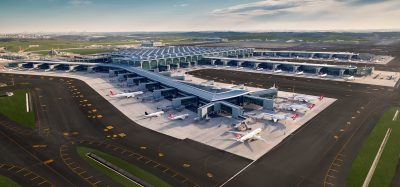Helsinki-Vantaa Airport responds to the demand for gateway traffic
- Like
- Digg
- Del
- Tumblr
- VKontakte
- Buffer
- Love This
- Odnoklassniki
- Meneame
- Blogger
- Amazon
- Yahoo Mail
- Gmail
- AOL
- Newsvine
- HackerNews
- Evernote
- MySpace
- Mail.ru
- Viadeo
- Line
- Comments
- Yummly
- SMS
- Viber
- Telegram
- Subscribe
- Skype
- Facebook Messenger
- Kakao
- LiveJournal
- Yammer
- Edgar
- Fintel
- Mix
- Instapaper
- Copy Link
Posted: 31 July 2007 | Mr. Reijo Tasanen Director of Finavia’s Airports Department [email protected] | No comments yet
Finavia started to build an extension to the international terminal at Helsinki-Vantaa in 2006. The investment also includes the baggage handling systems for the entire terminal. This investment of roughly EUR 140 million, the largest in Finavia’s history, illustrates our strong commitment to a future built on Asian gateway traffic. Approximately one half of the investment will go towards the construction of the new baggage handling centre.
Finavia started to build an extension to the international terminal at Helsinki-Vantaa in 2006. The investment also includes the baggage handling systems for the entire terminal. This investment of roughly EUR 140 million, the largest in Finavia’s history, illustrates our strong commitment to a future built on Asian gateway traffic. Approximately one half of the investment will go towards the construction of the new baggage handling centre.
The Asian gateway traffic puts us in a good position compared with our neighbouring countries: there are as many as 50 direct flights leaving Helsinki-Vantaa per week to around ten destinations in Asia. For example, there are around 100 flights to China each month. The shortest route from Asia to Europe is via Helsinki-Vantaa Airport.
The other implication of the Far Eastern traffic is its impact on European traffic. Around 80 per cent of passengers from Finnair’s Asia services change planes at Helsinki-Vantaa. Therefore, the Far Eastern traffic also strengthens route traffic and the destination network in Europe. There are direct flight connections from Helsinki-Vantaa to over 40 destinations in Europe.
Helsinki-Vantaa Airport handled around 12 million passengers in 2006. Its role as a gateway airport between Europe and Asia is becoming more prominent. In 2006 the number of gateway passengers to Asia increased by a record 34 per cent to 256,000 passengers. The total number of gateway passengers increased by 21 per cent and almost reached the 700,000 passenger mark.
From the perspective of passengers travelling from the Far East to Europe, Helsinki-Vantaa is a tempting alternative: in addition to the shorter route, it offers good connections to European cities together with services at an airport that is pleasant and uncrowded. Helsinki-Vantaa was judged to be Europe’s most punctual airport (AEA, 2005) and one of the best airports in the world for its level of service (IATA, AETRA, 1997 – 2005, Skytrax 2006).
Three runways provide enough capacity for the growth in air traffic. Helsinki is a popular gateway, especially for travel to mid-sized European cities; there are often direct connections available to big cities from various airports in Asia. Helsinki-Vantaa offers more direct flights to destinations in Europe than, for example, Arlanda in Stockholm or Oslo’s airport.
In 2006 the most popular destinations in Asia were China (+24 %), Thailand (+27 %) and Japan (+33 %) and the most popular destinations in Europe were Sweden (+6 %), Germany (+11 %) and Great Britain (+19 %).
As a result of the growth in gateway traffic, we will be investing significantly in the development of Helsinki-Vantaa Airport in the coming years. We aspire to offer services that are of the highest level in Europe and to keep our prices affordable by European standards. The extension to the international terminal is the largest investment in Finavia’s history and will serve traffic to Asia at Helsinki-Vantaa. The investment will be completed in autumn 2009. Services for business will be improved with the Hilton hotel (autumn 2007) and the two WTC office buildings (autumn 2008).
The extension serves the increasing gateway-traffic
The extension to the international terminal and the new Baggage Handling System (BHS), support Finavia’s strategy of developing Helsinki-Vantaa into Europe’s leading gateway between Asia and Europe. New passenger and baggage areas and five new passenger boarding bridges for wide-bodied aircraft will allow Helsinki-Vantaa to keep the transfer-time as short as possible and make changing aircraft fast and flexible.
The investment decision to expand the international terminal was taken by Finavia in August 2006 and excavation work started at the same time. The new building is an extension to the international flights passenger terminal. Passenger entry from the existing international flights terminal (T2) will be provided by two connecting bridges.
The new building will have three floors. The two lowest floors will serve baggage handling, three bus terminals, technical areas and a fire station. The baggage handling areas, located in the lower floors of the extension, will handle most of the baggage from international flights at the airport. The gross floor space of the building is 37,000 square metres, of which a gross area of 20,000 square metres will serve baggage handling. The apron will be expanded by 45,000 square metres and 120,000 square metres of existing apron will be refurbished.
A baggage conveyor tunnel running to the existing terminal areas will be built in the expanded terminal. A 300-metre long tunnel will be dug through the rock for the baggage conveyors, which will connect the centre to the existing terminals. In this way, the construction work will not interfere at all with ground and air traffic, so traffic can operate normally. The tunnel will connect the existing baggage handling halls to the new BHS.
Once the construction project is completed in autumn 2009, Helsinki-Vantaa will have eight passenger boarding bridges for wide-bodied aircraft. These bridges will help make it possible for the airport to accommodate large MD-11 and Airbus A340 aircraft arriving at a rapid rate from the Far East and to flexibly transfer the majority of the passengers to flights departing for European destinations. The minimum transfer-time at Helsinki-Vantaa is 35 minutes.
When completed, the extended international terminal at Helsinki-Vantaa has been designed to handle 15–16 million passengers per year and 13.5 million items of baggage.
The new baggage handling system
A preliminary design of the new BHS has been completed, which was prepared in cooperation with Finavia’s experts. The system will be designed first, so the extension building itself will be built ‘around’ the system. The new BHS takes up 20,000 square metres of floor space and is located on two floors.
The extension will contain eight passenger boarding bridges for wide-bodied aircraft. According to the design, the baggage from three wide-bodied aircraft can be handled in 15 minutes. For the purposes of calculations, three of these aircraft can be considered to contain 750 bags. The system can handle the baggage from 12 wide-bodied aircraft in one hour.
In transfer traffic, it is possible to handle 3,000 bags in one hour, whereas it is possible to handle 3,500 bags per hour from departing passengers arriving through check-in. A large investment in serving transfer traffic has been made and the investment focuses on responding to the increasing demand.
Helsinki-Vantaa’s main concept is travel with short transfer times, but other concepts are being developed alongside it: for example, passengers arriving on flights between 10 am–12 am can spend a few hours at the airport to get to know the airport’s services and then continue on their trip to Central Europe on an afternoon flight. Another concept envisages air passengers arriving at the airport in the early evening or evening, spending the night in the airport hotel and being relaxed and rested the next day for business meetings that can be held, for example, at the airport hotel. One of Finavia’s subsidiaries is investing in an airport hotel that is being constructed next to the international terminal. The hotel will serve gateway and business passengers in particular.
The system includes a 100 per cent security check of the baggage and an early bags store that will have room for approximately 1,500 bags. The third element of the system are sorters, which allow the sorting of baggage to around 80 destinations.
The handling times in the new system are a maximum of 15 minutes. The handling of bags for transfer traffic takes a minimum of 8 minutes and a maximum of around 14 minutes. For departure traffic, the times are always under 13 minutes. With regard to checked-in bags for departure traffic, it is not as challenging to stay on schedule as it is for baggage handling for transfer traffic, as departing passengers usually arrive at the airport well in advance. Dependability is even more important than being exactly on time: the goal is to develop the system to be as reliable as possible, even if that means sacrificing a few seconds.
Schedules
At the moment, a contractor is being sought for the system through a call for tenders and an agreement will be signed with the contractor in autumn 2007. Installation work will start in summer 2008 and the work will be completed by summer 2009. All baggage handling will be transferred to the new system in summer 2010.
It will be possible to handle bags for transfer traffic using the new system by the end of 2009. After that, the old baggage halls (baggage halls 1, 2 and 3) will be connected to the new system one by one so that the process is completed by 2010.
Reijo Tasanen
Reijo Tasanen has over 30 years experience in the aviation industry. In 1974 he joined the National Board of Aviation, where he worked for 17 years in positions ranging from Section Manager to General Manager. In 1991 he moved to Finavia’s technical services unit where he was a project manager. Recently he became Director for Airports, responsible for the construction and maintenance of runways and terminals and for terminal services and processes at Finavia.


















